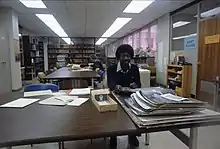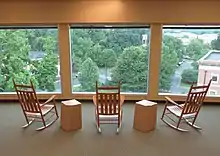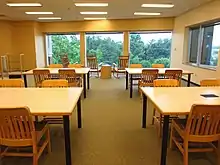Archives of Appalachia
The Archives of Appalachia is located on the campus of East Tennessee State University (ETSU) in Johnson City, Tennessee. The Archives of Appalachia is a repository for memories — the written words, images, and sounds that document life in southern Appalachia. the archives steward nearly two miles of rare manuscripts, 250,000 photographs, 90,000 audio and moving image recordings, and 14,000 books. More than 2,000 visitors from ETSU and around the globe utilize the collections each year for scholarly and creative projects. The Reading Room is open to the public Monday through Friday from 9:00 a.m. to 4:30 p.m

Early History
The Archives of Appalachia at East Tennessee State University (ETSU) opened on September 1, 1978 located on the first floor of what is now known as Nicks Hall. Created as part of the Institute of Appalachian Affairs by Dr. Arthur H. DeRosier, Jr., newly appointed President of ETSU, its mission was to coordinate research and public service relating to the sociological, political, economic and cultural aspects of life in southern Appalachia. Dr. Richard M. Kesner served as the first Director from 1978 to 1981. Early collections included the Washington County Court Records 1777-1950, the East Tennessee Education Association Papers, the LeRoy Reeves Papers, and the B. Carroll Reece Papers. Under Kesner's direction, the Archives added other valuable collections, including the Carolina, Clinchfield and Ohio Railway Records, the Magnet Mills Collection, and the Broadside Television Collection.

From the Archives' beginning, institutional and public outreach played a vital role in achieving notable goals. Grants in 1979 and 1981 from the Tennessee Endowment for the Humanities[1] and the National Endowment for the Humanities[2] allowed the Archives to develop the Appalachian Outreach Program, through which it produced nine slide-tape presentations about the region for teachers and community groups. The Archives developed teaching packets to accompany the presentations, which included transcripts, bibliographies, and suggested classroom activities for public school students.
After the departure of Dr. Richard Kesner, Dr. Ellen Garrison served as Director from July 1982 to January 1987. In 1982, the Tennessee Committee for the Humanities awarded a grant for the Archives to develop a series of three radio programs titled “Tennessee’s Mountain Heritage.” Based on material from the Archives' collections, the series was broadcast over the WETS radio station in May of 1983. Under Garrison's direction, the Archives implemented a computerized access system in 1986 and hired Norma (Myers) Thomas as Technical Services Archivist. Dr. Garrison resigned as director of the Archives in January 1987.
Center for Excellence in Appalachian Studies and Services
In 1984, as a part of the state’s Better Schools Program passed by the 1984 legislature, ETSU inaugurated the Center of Excellence for Appalachian Studies and Services (CASS).[3] CASS included the Institute for Appalachians Affairs, the B. Carroll Reece Museum and the Archives of Appalachia.The Archives acquired additional space when the medical library moved out of Sherrod Library. The additional space allowed for a conference room, map and over-sized material room, as well as additional storage space. In 1986, in recognition of ETSU’s 75th anniversary, the Archives produced a series of exhibits on ETSU's history and helped prepare a time capsule that was deposited in one of the globe columns at the campus amphitheater. The time capsule was opened during the ETSU’s 100th anniversary in 2011.
In 1988, Norma (Myers) Riddle became the Archives’ third director. Under Riddle’s leadership, the Archives continued its robust growth, adding hundreds of new collections on a range of historical and cultural topics related to southern Appalachia. Significant additions included the papers of the long-serving member of the U.S. House of Representatives James H. Quillen; the Coal Employment Project Papers, which document the struggle for workers’ rights for female coal miners; the records of the East Tennessee & Western North Carolina Railroad; and unique recorded sound collections including the Mary Elizabeth Barnicle and Tillman Cadle Collection of field recordings from the 1930s through the 1950s.
Increased media collections created unique demands for preservation and access, and during Riddle’s tenure the Archives applied for, and received, at least a dozen grants to preserve rare audio and moving image holdings. A major grant from the NEH in 2003 funded a large preservation project and also served as the basis for the creation of the Archives’ media digitization lab. Over time, the lab has developed the capacity for digitizing over a dozen formats of analog audio and moving image materials. Outreach also remained a focus for the Archives throughout the 1990s and beyond. From 1994-1995, the Archives worked with Panther Press to publish a two-volume series of D.R. Beeson’s hiking diaries. The series, edited by Riddle and Archivist Ned Irwin, was titled In the Spirit of Adventure and featured diary transcripts and photographs of hikes that D.R. Beeson and C. Hodge Mathes made of the Great Smoky Mountains (1914) and Mt. Mitchell (1915).
In the 1990s, work promoting digital access to collections continued. In 1996, the Archives entered the digital era with the launching of its first homepage, and in 1997 it was selected to participate in the “Monticello Electronic Library” pilot project, which was an attempt to make available online collection descriptions for 22 repositories in the southeast. In 1997, the administrative responsibility of the Archives, previously shared between the Center for Appalachian Studies and the University Library, was changed to the Center only and the Archives was restructured. Previously known as the Archives and Special Collections with subdivisions of Archives of Appalachia, University Archives, and Special Collections, the name was officially changed to the Archives of Appalachia,[4] consisting of three units – Appalachian Manuscript Collections, University Archives, and Special Collections.
In 1999, the Archives of Appalachia received a grant from the National Academy of Recording Arts and Sciences[5] to preserve selected recordings and to develop a radio series drawing on the materials in these collections. The one-hour weekly radio series, titled "From the Archives," was broadcast on WETS public radio station and featured performances of a range of traditional music. In 2000, the Archives was awarded a grant by the National Historical Publications and Records Commission[6] to preserve original and rare recordings in the Barnicle-Cadle, Bernard Rousseau, and Broadside Television collections and make them more accessible to researchers. As part of an effort to make its collections more accessible, the Archives posted all of its finding aids available online by 2000.
21st Century and a new library
On February 1, 1999 the Archives moved from its original location in what is now known as Nicks Hall to its present location on the fourth floor of the Charles C. Sherrod Library. With the move, the Archives acquired much-needed storage space for its rapidly growing collections. It also received increased space for its public reading room and dedicated facilities for its state-of-the-art media preservation lab. The relocation allowed the Archives to continue expanding its manuscript holdings and to extend both its educational and public services. In 2001, the Archives received a grant from the National Film Preservation Foundation[7] to preserve and make prints of four film documentaries produced by ETSU professors Thomas Burton and Jack Schrader. Produced in the 1970s, the four films – “Buckwheat,” “Gandy Dancers,” “Ott Blair: Sled-maker,” and “Alex Stewart: Cooper” – examine traditional work and crafts as practiced in Appalachia and juxtapose these activities against the pressures of modernization. In 2002, the Archives acquired the Kenneth W. Smith Collection, consisting of 17,000 sound recordings of country and bluegrass music. In 2006, the Archives expanded its recorded sound collections once again with the acquisition of the Lewis Deneumoustier Collection, consisting of over 25,000 recordings along with a large number of publications and ephemera that focus on country and bluegrass music.

In July 2010, ETSU selected Amy Collins as the Archives’ fourth director after Norma Myers Riddle retired. Collections growth continued, and Collins placed an emphasis on formalizing a range of policies that clarified workflows and standardized collection development and research access. The Archives also officially initiated an education and outreach program in 2012, with the hiring of its first Education and Outreach Archivist. As a result of this program, additional resources were devoted to supporting student research and scholarship, including the creation of a new electronic classroom and student learning center in 2014. At the same time, Archives staff curated a major new permanent exhibit in the reading room, highlighting the broad range of scholarly and creative projects that the Archives’ collections have supported over time. Work digitizing collections also continued, as the Archives laid the groundwork for a partnership with the Sherrod Library’s Digital Commons to provide online access to official ETSU publications.
Upon Collins’ retirement in 2018, ETSU selected Dr. Jeremy A. Smith as the Archives’ fifth director. Since that time the Archives has continued to emphasize digital access to collections, establishing its first digital collections portal in the summer of 2019, enhancing its infrastructure for digitizing oversize print items, and providing file-based streaming access to a portion of its media collections. The Archives has also enjoyed continued success in receiving grants, including two in 2019 from the Gladys Krieble Delmas Foundation and the National Recording Preservation Foundation that allowed the Archives to enhance access to its recorded sound collections. In 2019 the Archives was also able to award its first research grants through the annual Margaret Anne Byrd Huffman Archives of Appalachia Endowment Grant which supports ETSU faculty members and students who utilize materials from the Archives in research or creative projects.
As the Archives looks to the future, it remains grounded in its ongoing commitment to excellence and its dedication to serving the people of southern Appalachia. The Archives has a proud history as a center for education and creativity that engages students, faculty, and the broader Appalachian community in historical and cultural inquiry. Through its unrivaled collections, innovative and collaborative history of outreach, and patron-centered service, the Archives continues along its original path of serving southern Appalachia by preserving the stories of the people and the institutions that have made this region what it is.
Timeline
1958
Washington County deposits its official court records at East Tennessee State College. The College Library designates a space for the records, which becomes known informally as the library archives. This is the first of two foundational collections for the future Archives of Appalachia. (In 2011 this material is transferred to its permanent home at the Washington County Archives in Jonesborough, TN.)
1968-1972
ETSU professors Thomas G. Burton and Ambrose N. Manning create the Oral History Archives. This multiyear project documents Appalachian folklore, music, and customs, and it includes groundbreaking ethnographic work in the Appalachian region. This is the second of two foundational collections for the future Archives of Appalachia.
September 2, 1978
East Tennessee State University founds the Archives of Appalachia to promote an awareness of and appreciation for southern Appalachia’s culture and history.
1978
ETSU hires Dr. Richard Kesner as the Archives’ first director. Kesner serves the institution from 1978-1981, laying a strong foundation of intentional collections growth and innovative outreach efforts. During these early years, the Archives receives manuscript, print, photographic, and media collections that document all aspects of life in Appalachia, laying the foundation for a collection that now extends from the 18th through the 21st centuries. Subjects include folk traditions, education, industry, transportation, religious practices, music, and the arts.
1979
ETSU formally establishes its University Archives as a division of the Archives of Appalachia with the transfer of the papers of the institution’s first three presidents: Sidney Gilbreath, Charles Sherrod, and Burgin Dossett.
The Archives receives two grants from the National Endowment for the Humanities (NEH) to develop its first major outreach project. Between 1979-1982 the Archives produces a series of nine multi-media outreach programs, along with study guides. The programs draw upon materials in the Archives’ collections and are presented hundreds of times to over 5,000 people for free throughout southern Appalachia.
1980
The Archives serves as a test facility for the SELGEM program (Self Generating Master) developed by the Smithsonian Institution for cataloging and indexing archival collections. The following year, the Archives is a part of an NEH-funded study of the use of computers in archival settings; one result of which is MARS (the Microcomputer Archives and Records Management System).
1982
Dr. Ellen Garrison joins the Archives as its second director. She coordinates a second major outreach program for the Archives titled “Tennessee’s Mountain Heritage.” This series of three radio shows, based on materials from the Archives’ holdings, provides an overview of various aspects of the social history and folklore of southern Appalachia. It airs on three separate Sunday evenings on the WETS radio station in May of 1983.
1984
ETSU receives a grant from the Tennessee Higher Education Commission (THEC) to establish the Center of Excellence for Appalachian Studies and Services (CASS). The Archives is one of three units of CASS, along with the Reece Museum and the Institute of Appalachian Affairs. Through this association, the Archives receives support for additional staff and equipment, as well as funding for a range of preservation and outreach projects.
1988
Norma (Myers) Riddle becomes the Archives’ third director. The Archives’ holdings continue their robust growth, adding hundreds of new collections on a range of historical and cultural topics related to southern Appalachia. Significant additions include:
· the papers of the long-serving member of the US House of Representatives James H. Quillen
· the Coal Employment Project Papers, which document the struggle for workers’ rights for female coal miners
· the records of the East Tennessee & Western North Carolina Railroad
· unique recorded sound collections including the Mary Elizabeth Barnicle and Tillman Cadle Collection of field recordings (1930s-1950s) and the Stoneman Family Papers.
1994
The Archives works with Panther Press to publish a two-volume series of hiking diaries from the D.R. Beeson, Sr. Papers. The series, edited by Norma Myers Riddle and Archivist, Ned Irwin, is titled In the Spirit of Adventure and features diary transcripts and photographs of hikes that D.R. Beeson and C. Hodge Mathes made of the Great Smoky Mountains (1914) and Mt. Mitchell (1915).
1996
The Archives launches its first homepage.
1997
The Archives participates in the “Monticello Electronic Library” pilot project, which is an attempt to make collection descriptions available online for 22 repositories in the southeast.
1998
The Archives receives a grant from the Grammy Foundation to preserve a portion of its media holdings. This is the first of nearly a dozen grants the Archives will receive over the next decade, totaling nearly $350,000, to preserve its collections.
1999
The Archives moves from its original location, in what is now known as Nicks Hall, to its present location on the fourth floor of the Charles C. Sherrod Library. This move gives the Archives much-needed space for collections storage, a larger reading room, and a dedicated facility for its state-of-the-art media preservation lab.
2000
The Archives achieves a milestone by making all of its collection finding aids available online.
2003
The Archives develops its in-house media digitization lab. Over time, the lab acquires the capacity for digitizing more than a dozen formats of analog audio and moving image materials, creating over 25 terabytes of digital files.
2004
The Archives produces a successful public film series that features rare films from its holdings, reaching over 1,500 people.
2010
ETSU selects Amy Collins as the Archives’ fourth director. The Archives formalizes a range of policies that clarify workflows and standardize collection development and research access.
2011
The Archives produces the DVD Ray Hicks and Other Beech Mountain Folks, featuring content from the Thomas Burton-Jack Schrader Film Collection.
2012
The Archives officially initiates an education and outreach program with the hiring of its first Education and Outreach Archivist.
2014
The Archives undergoes a significant facilities renovation that includes the creation of a new electronic classroom and student learning center, along with the curation of a major new permanent exhibit in the reading room that highlights the broad range of scholarly and creative projects that the Archives’ collections have supported over time.
2018
ETSU hires Dr. Jeremy A. Smith as the Archives’ fifth director.
2019
The Archives launches the Margaret Anne Byrd Huffman Archives of Appalachia Endowment Grant, which is awarded annually to support ETSU faculty members and students who utilize materials from the Archives in research or creative projects.
The Archives places increased emphasis on providing digital access to its collections, establishing its first digital collections portal, enhancing its infrastructure for digitizing oversize print items, and providing online streaming access to a portion of its media collections.
The Archives receives grants from the Gladys Krieble Delmas Foundation and the National Recording Preservation Foundation that allow for enhanced access to its recorded sound collections.
Types of Collections
References
- "Our Story". Humanities Tennessee. Retrieved 2019-11-18.
- "Home". National Endowment for the Humanities (NEH). Retrieved 2019-11-18.
- "Center for Appalachian Studies and Services". www.etsu.edu. Retrieved 2019-11-18.
- "Archives of Appalachia". ETSU Archives of Appalachia. Retrieved 2019-11-18.
- "BEHIND THE RECORD". GRAMMY.com. 2017-03-24. Retrieved 2019-11-18.
- "National Historical Publications and Records Commission (NHPRC)". National Archives. 2016-08-11. Retrieved 2019-11-18.
- "National Film Preservation Foundation: Home". www.filmpreservation.org. Retrieved 2019-11-18.
